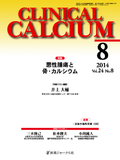- 有料閲覧
- 文献概要
- 1ページ目
- 参考文献
多発性骨髄腫は,骨に親和性を持ち進行性の骨破壊病変を形成し,骨病変部微小環境に依存した腫瘍進展を示す。骨髄腫細胞は骨微小環境と密接な相互作用を営み,RANK ligand依存性に破骨細胞形成が亢進し,その一方で骨芽細胞分化が強力に抑制され,広範な骨破壊病変が形成される。骨髄腫では複数の骨形成抑制因子が過剰産生されているが,これらの抑制因子のシグナルの下流で骨髄間質細胞にはgrowth factor independence-1(Gfi-1)やPim-2が発現誘導され,Gfi-1やPim-2が骨形成を抑制する媒介因子として枢軸的な役割を演じている。骨髄腫における骨細胞の実態の解析も進みつつあり,骨髄腫では生存骨細胞が減少し,溶骨性骨病変の形成と関連していることが示されている。
Multiple myeloma(MM)develops and expands almost exclusively in the bone marrow, and generates devastating bone destruction. MM cells produce a variety of cytokines to stimulate RANK ligand-mediated osteoclastogenesis and suppress osteoblastic differentiation from bone marrow stromal cells, leading to extensive bone destruction with rapid loss of bone. Pim-2 kinase as well as growth factor independence-1(Gfi-1)were found to be up-regulated in bone marrow stromal cells by major inhibitors of bone formation known in myeloma as common downstream mediators for the suppression of osteoblastogenesis. The biology of osteocytes is largely unknown in myeloma bone lesions, but the reduction of viable osteocytes and their correlation with osteoclastogenesis have been demonstrated.



